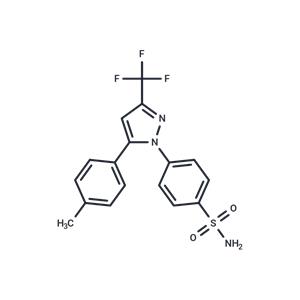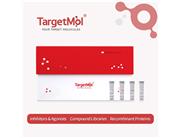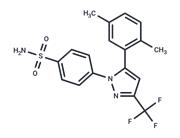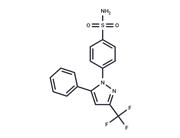| Name | Celecoxib |
| Description | Celecoxib (SC 58635) is a Nonsteroidal Anti-inflammatory Drug. The mechanism of action of celecoxib is as a Cyclooxygenase Inhibitor. |
| Cell Research | The antiproliferative effect of Celecoxib on NPC cells is assessed using an MTT assay. Cells are seeded into 96-well plates and allowed to attach for 24 hours. The cells are then treated with increasing concentrations of Celecoxib (0 to 75 μM) dissolved in DMSO (final concentration ≤0.1%) and incubated for up to 48 hours. After the incubation, 20 μL of MTT dye (5 mg/mL) are added to each well and cells are incubated at 37 °C for 4 hours. After removing the supernatants, the crystals are dissolved in DMSO and the absorbance is measured at 490 nm. The half-maximal inhibitory concentration (IC50) values and the 95% confidence intervals are calculated using probit regression using SPSS 15.0 software. The experiment is performed in triplicate and repeated at least three times.(Only for Reference) |
| Kinase Assay | COX enzyme assay in vitro: Expression of COX protein in insect cells is determined by assessing PG-synthetic capability in homogenates from cells incubated for 3 days with COX-1 or COX-2 baculovirus. Cells expressing COX-1 or COX-2 are homogenized and incubated with arachidonic acid (10 μM). COX activity is determined by monitoring PG production. No COX activity is detected in mock-infected Sf9 cells. Celecoxib are preincubated with crude 1% CHAPS homogenates (2-10 μg of protein) for 10 minutes before addition of arachidonic acid. PGE2 formed is detected by ELISA after 10 minute incubation. |
| In vitro | In rats, Celecoxib at doses ranging from 200 to 600 mg/kg does not induce acute gastrointestinal (GI) toxicity. Furthermore, continuous treatment with Celecoxib at these dosages for over ten days fails to produce GI toxicity. In the adjuvant-induced arthritis model, Celecoxib mitigates chronic inflammation with an effective dose 50 (ED50) of 0.37 mg/kg. Additionally, the compound exhibits analgesic activity in the Hargreaves pain model, with an ED50 of 34.5 mg/kg. |
| In vivo | Celecoxib inhibits cell proliferation in nasopharyngeal carcinoma cell lines HNE1 (IC50=32.86 μM) and CNE1-LMP1 (IC50= 61.31 μM). It also selectively inhibits COX-1 (IC50=15 μM) and COX-2 (IC50=40 nM) with effective selectivity. |
| Storage | Powder: -20°C for 3 years | In solvent: -80°C for 1 year | Shipping with blue ice. |
| Solubility Information | 10% DMSO+40% PEG300+5% Tween 80+45% Saline : 7.1 mg/mL (18.62 mM), Please add co-solvents sequentially, clarifying the solution as much as possible before adding the next one. Dissolve by heating and/or sonication if necessary. Working solution is recommended to be prepared and used immediately.
Ethanol : 31 mg/mL (81.3 mM)
2% DMSO+40% PEG300+5% Tween 80+53% H2O : 3 mg/mL (7.87 mM), Please add co-solvents sequentially, clarifying the solution as much as possible before adding the next one. Dissolve by heating and/or sonication if necessary. Working solution is recommended to be prepared and used immediately.
DMSO : 60 mg/mL (157.33 mM)
|
| Keywords | inhibit | Inhibitor | COX | Celecoxib | Cyclooxygenase | SC-58635 | SC58635 |
| Inhibitors Related | Ibuprofen | Acetaminophen | Salicylamide | Diclofenac sodium | Diclofenac Potassium | Paradol | Indomethacin sodium hydrate | Trometamol | Glafenine | Revaprazan hydrochloride |
| Related Compound Libraries | Pain-Related Compound Library | Bioactive Compound Library | Anti-Neurodegenerative Disease Compound Library | EMA Approved Drug Library | Drug Repurposing Compound Library | Inhibitor Library | FDA-Approved Drug Library | Anti-Aging Compound Library | Bioactive Compounds Library Max | Anti-Cancer Drug Library |

 United States
United States



